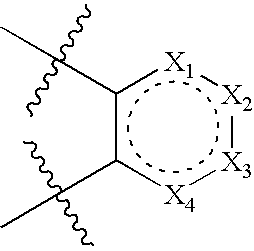Modulators of glucocorticoid receptor, AP-1, and/or NF-kappaB activity and use thereof
a technology which is applied in the field of new nonsteroidal compounds, can solve the problems of limited systemic use of glucocorticoid receptor and ap-1
- Summary
- Abstract
- Description
- Claims
- Application Information
AI Technical Summary
Problems solved by technology
Method used
Image
Examples
preparation 1
Step 1
[0321]
Ref: B. Bacle and G. Levesque, Polymer Communications, 28, 36 (1987).
[0322]A 1 L flask was charged with anthracene (14 g, 0.078 mol, 1.0 equi.), hydroquinone (0.8 g, 0.008 mol, 0.1 equi.), methacrylic acid (14 mL, 0.156 mol, 2.0 equi.) and xylene (500 mL). The solution was heated to reflux for 1 day. The solution was cooled and concentrated in vacuo. The residue was dissolved in ethyl acetate and extracted with 1N NaOH (3×). The aqueous phase was acidified with 1N HCl, and the product was extracted with ethyl acetate (3×). The combined organic phases were concentrated in vacuo to give the crude product mixture. Recrystallization with hexane and ethyl acetate to yield 8 g (40%) of the product of step 1, 1:LC / MS (m / z 263 (M−H)+); 1H NMR (CDCl3) δ 7.08-7.25 (m, 8H), 4.37 (s, 1H), 4.25(t, 1H), 2.61 (dd, 1H), 1.39 (dd, 1H), 1.07 (s, 3H).
Step 2
[0323]
[0324]To a solution of the title product of 1 (3 g, 11.36 mmol) in DMF (3 mL) were added 1-[3-(dimethylamino)propyl]-3-ethylcarbo...
example 1
[0328]
[0329]To a solution of the title compound of 3 (60 mg, 0.143 mmol), from Preparation 1, Step 3, in THF (1 ml) were added DMF (0.023 ml) and oxalyl chloride (2M in dichloromethane, 0.72 ml, 1.43 mmol) at 0° C. The reaction mixture was allowed to warm to room temperature and stirred for 30 min. to afford the crude product of the acid chloride. The crude acid chloride was taken in dichloromethane and cooled to 0° C. To the solution was added a cold solution of 1-(2-pyridinyl)piperazine (0.044 ml, 0.286 mmol) and triethyl amine (0.060 ml, 0.423 mmol). The reaction mixture was stirred at 0° C. for 5 hours and room temperature for an additional 2 hours. The reaction mixture was concentrated and purified through HPLC to provide the tittle compound of Example 1 as a white solid (31 mg, 38.5% yield). LC / MS m / z 564.28, (M+1)+; HPLC Rt: 2.97 min. 99% purity.
examples 2 to 16
[0330]In a similar manner to Example 1, Examples 2-16 were prepared from the compound 3 and appropriate amines.
[0331]
MSHPLCaExample #—NR1R2[m / z (M+H)]Rt: minutes2538.414.033515.442.894476.373.665488.423.626563.334.077494.264.158524.264.139538.273.9410542.234.2111593.143.96125982.13136212.05146051.98156312.14166322.12a.For Examples 1-11, HPLC condition: 10% to 90% MeOH / H2O / 0.1% TFA, 2.0 min. 2 min. gradient. Column: Shimadzu VP-0DS; C-18 Ballistic, 4.6 × 50 mm (5 micron), 4.0 mL / min. flow rate, 220 nm detection wavelength.b.For Examples 12-16, HPLC condition: 10% to 90% MeOH / H2O / 0.1% TFA, 2.0 min. gradient. Column: PrimeSphere C18-HC 4.6 × 30 mm (5 micron), 5.0 mL / min. flow rate, UV 220 nm, MS detection.
PUM
| Property | Measurement | Unit |
|---|---|---|
| temperature | aaaaa | aaaaa |
| temperature | aaaaa | aaaaa |
| temperature | aaaaa | aaaaa |
Abstract
Description
Claims
Application Information
 Login to View More
Login to View More - R&D
- Intellectual Property
- Life Sciences
- Materials
- Tech Scout
- Unparalleled Data Quality
- Higher Quality Content
- 60% Fewer Hallucinations
Browse by: Latest US Patents, China's latest patents, Technical Efficacy Thesaurus, Application Domain, Technology Topic, Popular Technical Reports.
© 2025 PatSnap. All rights reserved.Legal|Privacy policy|Modern Slavery Act Transparency Statement|Sitemap|About US| Contact US: help@patsnap.com



